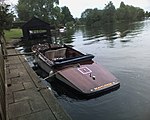
A kayak is a small, narrow watercraft which is typically propelled by means of a double-bladed paddle. The word kayak originates from the Greenlandic word qajaq.

A dory is a small, shallow-draft boat, about 5 to 7 metres or 16 to 23 feet long. It is usually a lightweight boat with high sides, a flat bottom and sharp bows. It is easy to build because of its simple lines. For centuries, the dory has been used as a traditional fishing boat, both in coastal waters and in the open sea.

A dinghy is a type of small boat, often carried or towed by a larger vessel for use as a tender. Utility dinghies are usually rowboats or have an outboard motor. Some are rigged for sailing but they differ from sailing dinghies, which are designed first and foremost for sailing. A dinghy's main use is for transfers from larger boats, especially when the larger boat cannot dock at a suitably-sized port or marina.

A scow is a type of flat-bottomed barge. Some scows are rigged as sailing scows. In the 19th and early 20th centuries, scows carried cargo in coastal waters and inland waterways, having an advantage for navigating shallow water or small harbours. Scows were in common use in the American Great Lakes and other parts of the U.S., in southern England, and in New Zealand. In Canada, scows have traditionally been used to transport cattle to the islands of New Brunswick's Saint John River. In modern times their main purpose is for recreation and racing.
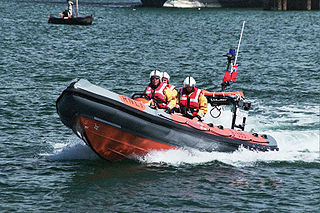
A rigid inflatable boat (RIB), also rigid-hull inflatable boat or rigid-hulled inflatable boat (RHIB), is a lightweight but high-performance and high-capacity unsinkable boat constructed with a rigid hull bottom joined to side-forming air tubes that are inflated with air to a high pressure so as to give the sides resilient rigidity along the boat's topsides. The design is stable, light, fast and seaworthy. The inflated collar acts as a life jacket, ensuring that the vessel retains its buoyancy, even if the boat is taking on water. The RIB is an evolutionary development of the inflatable boat with a rubberized fabric bottom that is stiffened with flat boards within the collar to form the deck or floor of the boat.
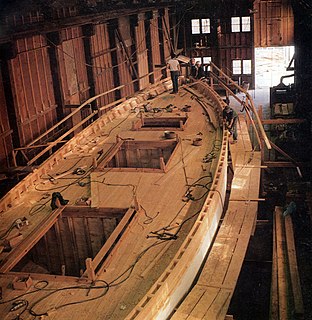
Boat building is the design and construction of boats and their systems. This includes at a minimum a hull, with propulsion, mechanical, navigation, safety and other systems as a craft requires.

Planing is the mode of operation for a waterborne craft in which its weight is predominantly supported by hydrodynamic lift, rather than hydrostatic lift (buoyancy).

A slipway, also known as boat ramp or launch or boat deployer, is a ramp on the shore by which ships or boats can be moved to and from the water. They are used for building and repairing ships and boats, and for launching and retrieving small boats on trailers towed by automobiles and flying boats on their undercarriage.
The Jersey Skiff is a beach launched boat first appearing around the end of the 19th century. They were first used as fishing boats, to be launched through the surf, sailed to the fishing grounds and then retrieved through the surf.

The United States' S-class submarines, often simply called S-boats, were the first class of submarines with a significant number built to United States Navy designs. They made up the bulk of the USN submarine service in the interwar years and could be found in every theater of operations. While not considered "Fleet Submarines" in the traditional sense of that term, they were the first submarines in the USN designed for open ocean, blue water operations. All previous submarines had been intended for harbor or coastal defense. These boats were intended to have greater speed and range than previous classes, with improved habitability and greater armament.
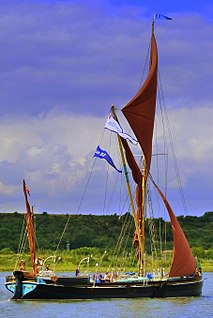
A Thames sailing barge is a type of commercial sailing boat once common on the River Thames in London. The flat-bottomed barges with a shallow draught and leeboards, were perfectly adapted to the Thames Estuary, with its shallow waters and narrow tributary rivers. The larger barges were seaworthy vessels, and were the largest sailing vessel to be handled by just two men. The average size was about 120 tons and they carried 4,200 square feet (390 m2) of canvas sail in six working sails. The mainsail was loose-footed and set up with a sprit, and was brailed to the mast when not needed. It is sheeted to a horse, as is the foresail; they require no attention when tacking. The foresail is often held back by the mate to help the vessel come about more swiftly.
A chine in boat design is a sharp change in angle in the cross section of a hull. The chine typically arises from the use of sheet materials as the mode of construction.

A whaleback was a type of cargo steamship of unusual design, with a hull that continuously curved above the waterline from vertical to horizontal. When fully loaded, only the rounded portion of the hull could be seen above the waterline. With sides curved in towards the ends, it had a spoon bow and a very convex upper deck. It was formerly used on the Great Lakes of Canada and the United States, notably for carrying grain or ore. The sole surviving ship of the "whaleback" design is the SS Meteor, which is docked in Superior, Wisconsin as a museum ship.
The North 26 is a boat designed by Julian D Everitt in 1982, Cowes UK, designer of the very successful E boat. Big brother to the E-boat, intended for Yacht racing Inshore and in Junior Offshore Group races to rate under Channel now IRC measurement rule. Examples race the English Channel and have a wide flat sole plate that enables them to sit the mud in English ports with the keel retracted. This feature also enables safe beach sitting whilst cruising and use as a Trailer yacht.
A Puddle Duck Racer or PD Racer is an 8 foot long, 4 foot (1.22 m) wide, 16 inch (40 cm) high, spec series, racing sailboat. It is a one design hull shape with wide options in other areas. Billed as "the easiest sailboat in the world to build", the scow hull is a simple box, usually built of plywood. PD Racers have a Portsmouth handicap rating of 140.0 and their USSA code is PDR.

The McKenzie River dory, or drift boat, is an adaptation of the open-water dory converted for use in rivers. A variant of the boat's hull is called a modified McKenzie dory or Rogue River dory. The McKenzie designs are characterized by a wide, flat bottom, flared sides, a narrow, flat bow, and a pointed stern. The sole identifying characteristic of the McKenzie River dory is a continuous rocker. It is this constant rocker that allows the boat to spin about its center for ease in maneuvering in rapids.
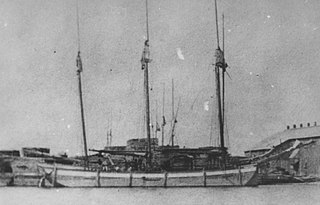
The Mayflower was a wooden hulled scow schooner that sank on June 2, 1891, in Lake Superior near Duluth, Minnesota, United States, after capsizing with a load of sandstone blocks. In 2012 the shipwreck site was added to the National Register of Historic Places.
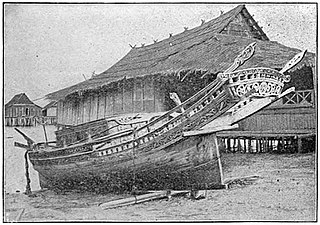
Lepa, also known as lipa or lepa-lepa, are indigenous ships of the Sama-Bajau people in the Philippines and Malaysia. They were traditionally used as houseboats by the seagoing Sama Dilaut. Since most Sama have abandoned exclusive sea-living, modern lepa are instead used as fishing boats and cargo vessels.

The Wey barge was based on the earlier West Country barge designs and the first barges built specifically for use on the Wey were probably built at Honeystreet Wharf, near Devizes. The earliest that this could be was 1810 as the Kennet and Avon Canal was opened through to the Thames that year.
The Slipper 17 is an American trailerable sailboat that was designed by Nick Hake as a pocket cruiser and first built in 1981.

